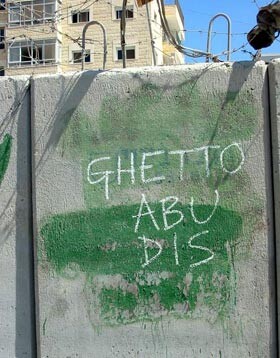The Electronic Intifada 17 February 2004

Photo: Jos Kostner, courtesy of Anti-Apartheid Wall Campaign
The visual and moral affront of the Apartheid Wall prompted these observations, expressed through a subtle Japanese poetic form, the haiku. An ancient Japanese literary form, the haiku embodies the principle that “less is more” and delights in mixing categories and crossing boundaries through the magic of metaphor.
Haikus are understated and simple. They consist of three verses, the first and last of which have five syllables, while the second has seven. Deceptively light and playful, a haiku often conveys harsh critiques and deeper meanings. And by linking images and ideas conventionally separated by the walls of everday logic, haikus can open windows on new perspectives and encourage new possibilities.
I.
Concrete smothers sky,
Shadows mar all they covet.
No birds can reach us.
II.
Separation Wall:
No branches, roots or flowers.
A grave in mid-air.
III.
Arrogant tower,
Robotic head so haughty.
How sad you can’t dance.
IV.
A scar legions long.
But the operation failed:
Bitterness infects the land.
V.
Their fathers, our sons
encircled by fear and hate.
Bricks are kin to slaves.
Laurie King-Irani, a co-founder of the Electronic Intifada, teaches anthropology in Victoria, British Columbia, and resorts to poetry when op eds and analyses fall on deaf ears.




